trailer PONTIAC GRAND AM 1998 Owners Manual
[x] Cancel search | Manufacturer: PONTIAC, Model Year: 1998, Model line: GRAND AM, Model: PONTIAC GRAND AM 1998Pages: 370, PDF Size: 16.11 MB
Page 75 of 370
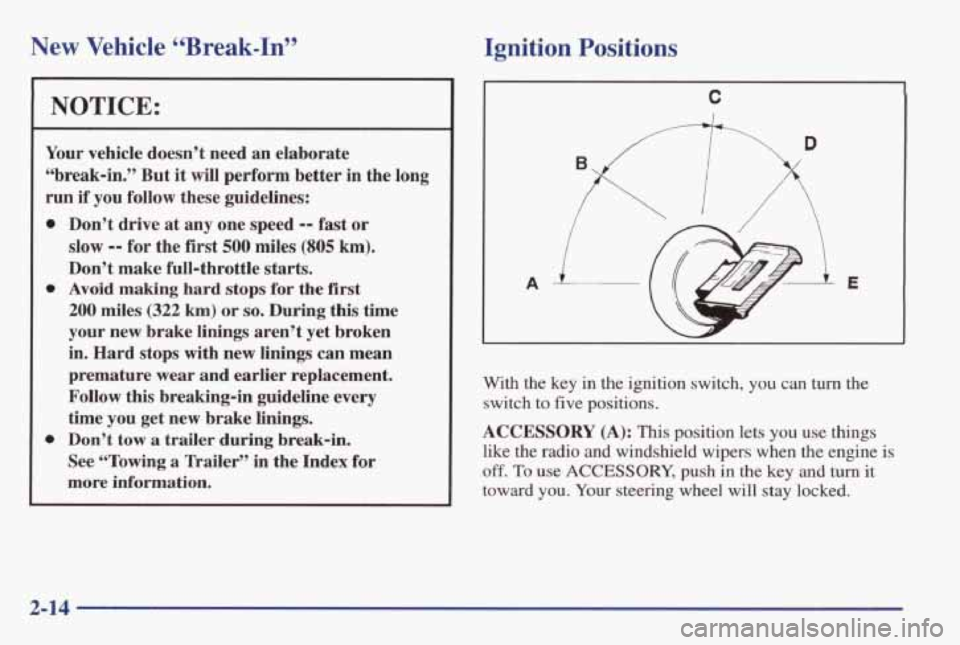
New Vehicle “Break-In”
NOTICE:
Your vehicle doesn’t need an elaborate
“break-in.” But it
will perform better in the long
run if you follow these guidelines:
0
0
Don’t drive at any one speed -- fast or
slow -- for the first 500 miles (805 km).
Don’t make full-throttle starts.
Avoid making hard stops for the first
200 miles (322 km) or so. During this time
your new brake linings aren’t yet broken
in. Hard stops with new linings can mean
premature wear and earlier replacement.
Follow this breaking-in guideline every
time you get new brake linings.
Don’t tow
a trailer during break-in.
See “Towing a nailer’’ in the Index for
more information.
Ignition Positions
C
With the key in the ignition switch, you can turn the
switch
to five positions.
ACCESSORY (A): This position lets you use things
like the radio and windshield wipers when the engine
is
off. To use ACCESSORY, push in the key and turn it
toward you. Your steering wheel will stay locked.
2-14
Page 82 of 370

Automatic Transaxle Operation
Your vehicle may be equipped with a four-speed
automatic transaxle. The
shift lever is located on the
console between the seats.
There are seven different
positions for the shift
lever
on the four-speed
N
@I
3
2
1
automatic transaxle.
PARK (P): This locks your front wheels. It’s the best
position
to use when you start your engine because your
vehicle can’t move easily.
A CAUTION:
It is dangerous to get out of your vehicle if the
shift lever is
not fully in PARK (P) with the
parking brake firmly set. Your vehicle can roll.
Don’t leave your vehicle when the engine is
running unless you have to.
If you have left the
engine running, the vehicle can move suddenly.
You or others could be injured. To be sure your
vehicle won’t move, even when you’re on fairly
level ground, always set your parking brake and
move the shift lever to PARK (P).
See “Shifting Into PARK (P)” in the Index. If
you’re pulling a trailer, see “Towing a Trailer’’ i~
the Index.
2-21
Page 84 of 370

AUTOMATIC OVERDRIVE (D): This position is for
normal driving with the four-speed automatic transaxle.
If you need more power for passing,
and you’re:
Going less than about 35 mph (55 km/h), push your
0 Going about 35 mph (55 km/h) or more, push the
The transaxle will automatically shift down to the next
gear and provide more power. accelerator pedal about halfway down.
accelerator all the way down.
NOTICE:
This NOTICE applies only if you have an
automatic overdrive transaxle. If your vehicle is
so equipped and if it seems to start up rather
slowly,
or if it seems not to shift gears as you go
faster, something may be wrong with a transaxle
system sensor.
If you drive very far that way,
your vehicle can be damaged. So, if this happens,
have your vehicle serviced right away. Until then,
you can use SECOND
(2) when you are driving
less than
35 mph (56 km/h) and AUTOMATIC
OVERDRIVE (0) for higher speeds. THIRD
(3): This
position is also used for normal
driving, however, it offers more power and lower fuel
economy than AUTOMATIC
OVERDRIVE (D). Here
are some times you might choose THIRD (3) instead of
AUTOMATIC
OVERDRIVE (D):
When driving on hilly, winding roads.
0 When towing a trailer, so there is less shifting
between gears.
0 When going down a steep hill.
SECOND
(2): This position gives you more power but
lower fuel economy. You can use
SECOND (2) on hills.
It can help control your speed
as you go down steep
mountain roads, but then you would also want
to use
your brakes off and on.
2-23
Page 88 of 370

Parking Brake
To set the parking brake, hold the regular brake pedal
down
with your right foot. Pull up on the parking brake
handle. If the ignition is on, the brake system warning
light will come on.
To release the parking brake, hold the regular brake
pedal down. Pull the parking brake lever up until you
can press the release button. Hold the release button in as you move the brake lever all the way down.
Driving with the parking brake on can cause
your rear brakes to overheat. You may have to replace them, and you could also damage other
parts
of your vehicle.
If you are towing a trailer and are parking on any hill,
see “Towing a Trailer” in the Index. That section shows
what to do first to keep the trailer from moving.
2-27
Page 89 of 370
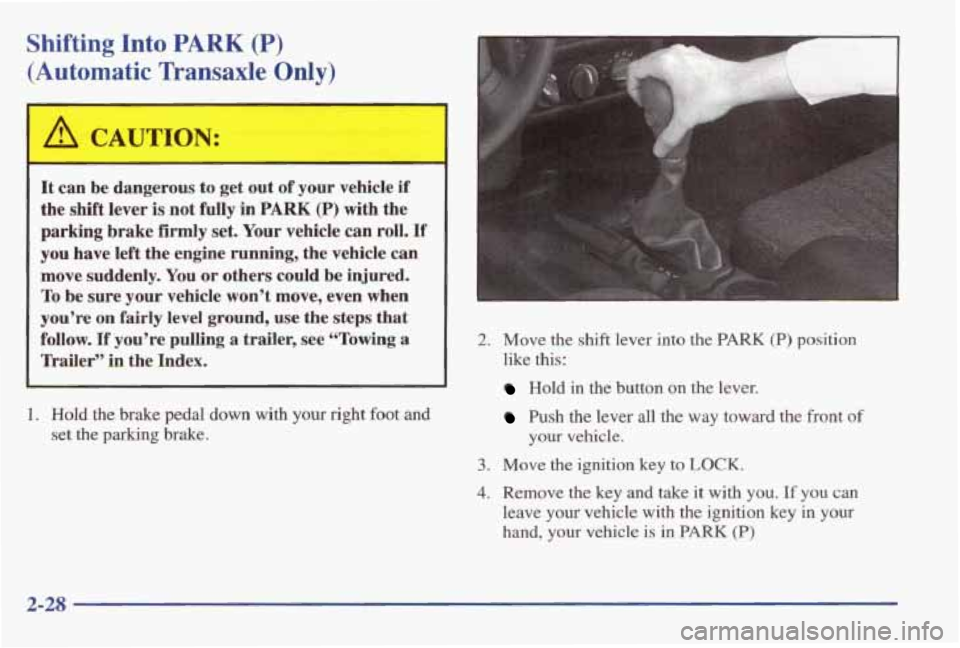
Shifting Into PARK (P)
(Automatic Transaxle Only)
A CAUTION:
It can be dangerous to get out of your vehicle if
the shift lever is not fully in PARK (P) with the
parking brake firmly set. Your vehicle can
roll. If
you have left the engine running, the vehicle can
move suddenly. You or others could
be injured.
To be sure your vehicle won't move, even when
you're on
fairly level ground, use the steps that
follow.
If you're pulling a trailer, see "Towing a
Tkailer" in the Index.
i
1. Hold the brake pedal down with your right foot and
set the parking brake.
2. Move the shift lever into the PARK (P) position
like this:
Hold in the button on the lever.
Push the lever all the way toward the front of
your
vehicle.
3. Move the ignition key to LOCK.
4. Remove the key and take it with you. If you can
leave your vehicle with the ignition key in your
hand, your vehicle is in
PARK (P)
2-28
Page 91 of 370
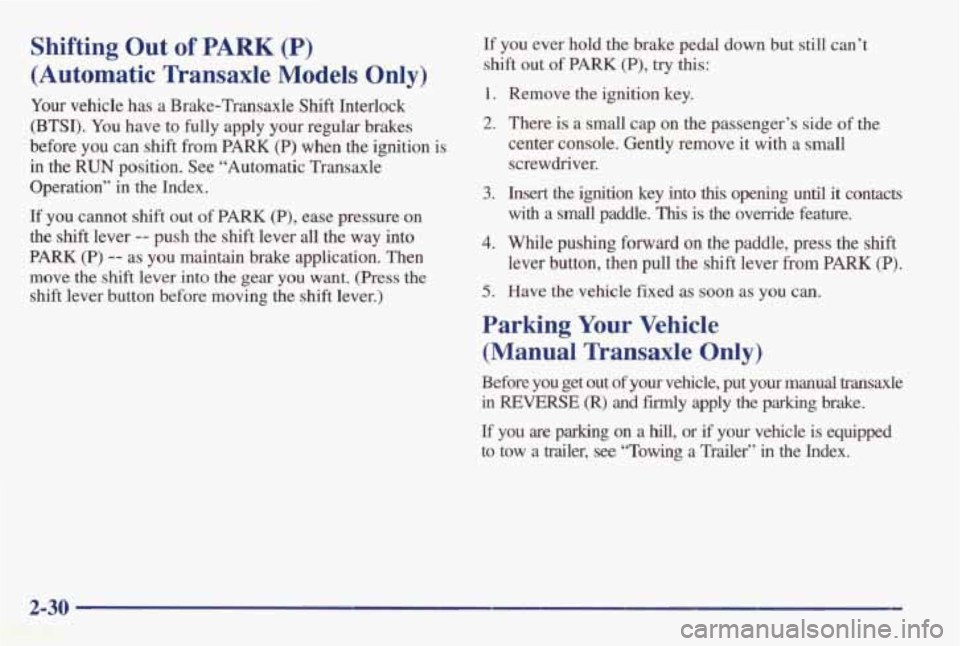
Shifting Out of PARK (P)
(Automatic Transaxle Models Only)
Your vehicle has a Brake-Transaxle Shift Interlock
(BTSI). You have to
fully apply your regular brakes
before you can shift from PARK
(P) when the ignition is
in the
RUN position. See “Automatic Transaxle
Operation” in the Index.
If you cannot shift out of PARK (P), ease pressure on
the
shift lever -- push the shift lever all the way into
PARK (P) -- as you maintain brake application. Then
move the shift lever into the gear you want. (Press the
shift lever button before moving the shift lever.) If you
ever hold the brake pedal down
but still can’t
shift out of
PARK (P), try this:
1. Remove the ignition key.
2. There is a small cap on the passenger’s side of the
center console. Gently remove it
with a small
screwdriver.
3. Insert the ignition key into this opening until it contacts
with a small paddle. This is the override feature.
4. While pushing forward on the paddle, press the shift
lever button, then pull the shift lever from PARK (P).
5. Have the vehicle fixed as soon as you can.
Parking Your Vehicle
(Manual Transaxle Only)
Before you get out of your vehicle, put your manual transaxle
in REVERSE (R) and firmly apply the parking brake.
If you are parking on a hill, or if your vehicle is equipped
to tow a trailer, see “Towing a Trailer’’ in the Index.
2-30
Page 93 of 370
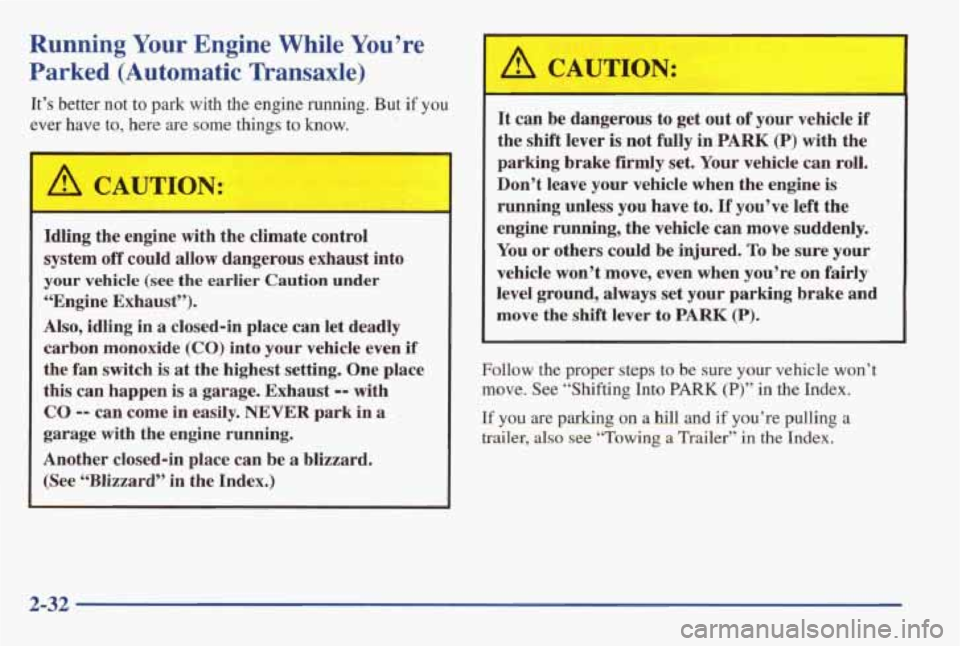
Running Your Engine While You’re
Parked (Automatic Transaxle)
It’s better not to park with the engine running. But if you
ever have to, here are some things to know.
I-
A CAUTION:
-
Idling the engine with the climate control
system
off could allow dangerous exhaust into
your vehicle (see the earlier Caution under
“Engine Exhaust”).
Also, idling in
a closed-in place can let deadly
carbon monoxide
(CO) into your vehicle even if
the fan switch is at the highest setting. One place
this can happen is a garage. Exhaust -- with
CO -- can come in easily. NEVER park in a .
garage with the engine running.
Another closed-in place can be
a blizzard.
(See “Blizzard” in the Index.)
A CAUTION:
-1
It can be dangerous to get out of your vehicle if
the shift lever is not fully in PARK (P) with the
parking brake firmly
set. Your vehicle can roll.
Don’t leave your vehicle when the engine
is
running unless you have to. If you’ve left the
engine running, the vehicle can move suddenly.
You
or others could be injured. To be sure your
vehicle won’t move, even when you’re
on fairly
level ground, always set your parking brake and
move the shift lever
to PARK (P).
Follow the proper steps to be sure your vehicle won’t
move. See “Shifting Into
PARK (P)” in the Index.
If you are parking on a hill and if you’re pulling a
trailer,
also see “Towing a Trailer” in the Index.
2-32
Page 124 of 370

NOTICE:
If you keep driving your vehicle with this light on, after a while, your emission controls may not
work as well, your fuel economy may not be as
good and your engine may not run as smoothly.
This could lead to costly repairs that may not
be
covered by your warranty.
This light should come on, as a check to show you it is
working, when the ignition is on and the engine is not
running. If the light doesn’t come on, have it repaired.
This light will also come on during a malfunction in one
of two ways:
Light Flashing -- A misfire condition has been
detected.
A misfire increases vehicle emissions and
may damage the emission control system on your
vehicle. Dealer or qualified service center diagnosis and service may be required.
malfunction has been detected on your vehicle.
Dealer or qualified service center diagnosis and
service may be required.
0 Light On Steady -- An emission control system
If the Light Is Flashing
The following may prevent more serious damage to
your vehicle:
0 Reducing vehicle speed.
0 Avoiding hard accelerations.
0 Avoiding steep uphill grades.
0 If you are towing a trailer, reduce the amount of
cargo being hauled as
soon as it is possible.
If the light stops flashing and remains on steady, see “If
the Light Is On Steady” following.
If the light continues to flash, when it is safe to do so,
stop the vehicle. Find a safe place to park your vehicle.
Turn the key
off, wait at least 10 seconds and restart the
engine.
If the light remains on steady, see “If the Light
Is On Steady” following.
If the light is still flashing,
follow the previous steps, and drive the vehicle
to your
dealer or qualified service center for service.
2-63
Page 158 of 370

Section 4 Your Driving and the Road
Here you’ll find information about driving on different kinds\
of roads and in varying weather conditions. We’ve also
included many other useful tips on driving.
4-2
4-3
4-6
4-6
4- 10
4-13
4-13
4- 14
4-16
4-18
Defensive Driving
Drunken Driving
Control of a Vehicle
Braking Steering
Off-Road Recovery
Loss of Control
Driving at Night
Driving in Rain
and on Wet Roads
Passing
4-2 1
4-22
4-23
4-24
4-24
4-26
4-30
4-33
4-35
City Driving
Freeway Driving
Before Leaving on a Long Trip
Highway Hypnosis
Hill and Mountain Roads
Winter Driving
Recreational Vehicle Towing
Loading Your Vehicle
Towing a Trailer
4-1
Page 192 of 370
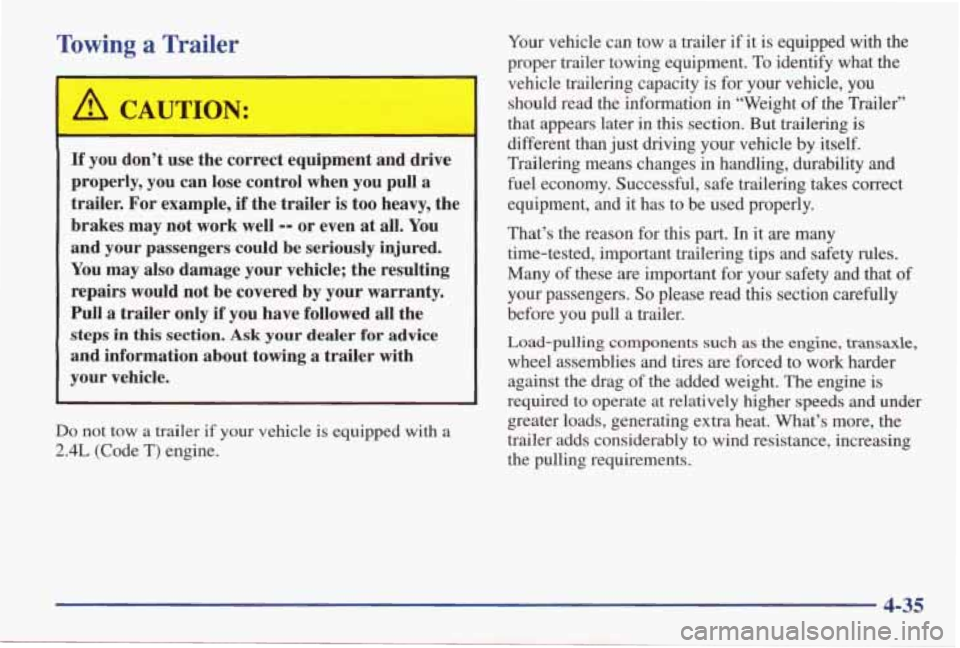
Towing a Trailer
I
If you don’t use the correct equipment and drive
properly, you can lose control when you pull a
trailer. For example,
if the trailer is too heavy, the
brakes may not work well
-- or even at all. You
and your passengers could be seriously injured.
You may also damage your vehicle; the resulting
repairs would not be covered by your warranty.
Pull a trailer only if you have followed all the
steps in this section. Ask your dealer for advice
and information about towing a trailer with
your vehicle.
>o not tow a trailer if your vehicle is equipped with a
!.4L (Code T) engine. Your
vehicle can tow a trailer if it is equipped with the
proper trailer towing equipment. To identify what the
vehicle trailering capacity is for your vehicle, you
should read the information in “Weight of the Trailer”
that appears later in this section. But trailering is
different than just driving your vehicle by itself.
Trailering means changes in handling, durability and
fuel economy. Successful, safe trailering takes correct
equipment, and it has to be used properly.
That’s the reason for
this part. In it are many
time-tested, important trailering tips and safety rules.
Many of these are important for your safety and that of
your passengers.
So please read this section carefully
before you pull a trailer.
Load-pulling
components such as the engine, transaxle,
wheel assemblies and tires are forced to work harder
against the drag of the added weight. The engine is
required to operate at relatively higher speeds and under
greater loads, generating extra heat. What’s more, the
trailer adds considerably to wind resistance, increasing
the pulling requirements.
4-35